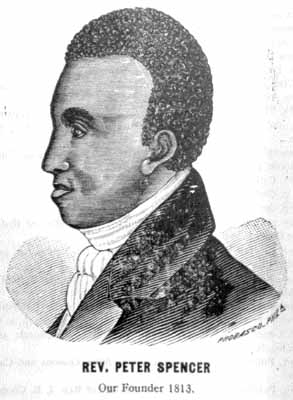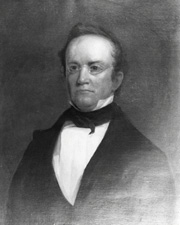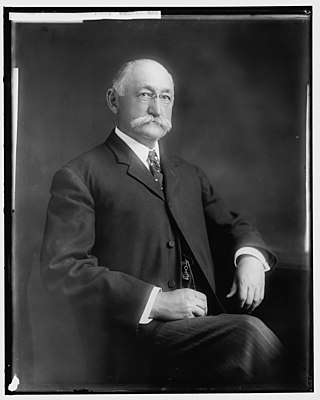
Peter Spencer (1782–1843) was an American freedman who in 1813 founded the Union Church of Africans in Wilmington, Delaware. The denomination is now known as the African Union First Colored Methodist Protestant Church and Connection, or A.U.M.P. Church for short. Born into slavery in 1782 in Kent County, Maryland, Spencer was freed after his master died, by the terms of his will.

John Wales was an American lawyer and politician from Wilmington, in New Castle County, Delaware. He was a member of the Whig Party who served as U.S. Senator from Delaware.

Thomas Garrett was an American abolitionist and leader in the Underground Railroad movement before the American Civil War. He helped more than 2,500 African Americans escape slavery.

John Hunn was an American businessman and politician from Camden, Delaware. The first governor elected after a reform of Delaware's state constitution and a compromise candidate, Hunn served from 1901 until 1905 and became the first of a multi-decade string of elected Republican Delaware governors.

Preston Lea was an American businessman and politician from Wilmington, in New Castle County, Delaware. He was a member of the Republican Party who served as Governor of Delaware.

Caleb Prew Bennett was an American soldier and politician from Wilmington, in New Castle County, Delaware. He was a veteran of the American Revolutionary War and the War of 1812, and a member of the Democratic Party who served as Governor of Delaware.

Samuel D. Burris was a member of the Underground Railroad. He had a family, who he moved to Philadelphia for safety and traveled into Maryland and Delaware to guide freedom seekers north along the Underground Railroad to Pennsylvania.

The 92nd Delaware General Assembly was a meeting of the legislative branch of the state government, consisting of the Delaware Senate and the Delaware House of Representatives. Elections were held the first Tuesday after November 1 and terms began in Dover on the first Tuesday in January. This date was January 6, 1903, which was two weeks before the beginning of the third administrative year of Governor John Hunn and Philip Cannon as Lieutenant Governor.

The 100th Delaware General Assembly was a meeting of the legislative branch of the state government, consisting of the Delaware Senate and the Delaware House of Representatives. Elections were held the first Tuesday after November 1 and terms began in Dover on the first Tuesday in January. This date was January 7, 1919, which was two weeks before the beginning of the third administrative year of Governor John G. Townsend, Jr. and Colen Ferguson as Lieutenant Governor.

Camden Friends Meetinghouse is a historic Quaker meeting house located on Delaware Route 10 in Camden, Kent County, Delaware. It was built in 1805, and was still in operation as a Quaker meeting house when it was listed on the National Register of Historic Places in 1973. A modern Camden Friends Meeting and Social Hall has been built behind the historic building, which now serves the meeting, and was designed to be energy-efficient and architecturally respectful of the historic building.

Appoquinimink Friends Meetinghouse, also known as the Odessa Friends Meetinghouse, is a very small but historic Quaker meetinghouse on Main Street in Odessa, Delaware. It was built in 1785 by David Wilson and added to the National Register of Historic Places in 1972. Members of the meeting, including John Hunn and his cousin John Alston, were active in the Underground Railroad and Harriet Tubman may have hid in the meetinghouse. Measuring about 20 feet (6.1 m) by 22 feet (6.7 m), it may be the smallest brick house of worship in the United States.

Friends Meetinghouse is a historic Quaker meeting house at 4th and West Streets in Wilmington, Delaware in the Quaker Hill neighborhood. The meeting is still active with a membership of about 400 and is part of the Philadelphia Yearly Meeting. It was built in 1815–1817 and added to the National Register of Historic Places in 1976.

Great Geneva is a historic home located near Camden, Kent County, Delaware. It was built in about 1765, and is a 2+1⁄2-story, brick, hall-and-parlor plan dwelling with a small frame kitchen wing. The layout is an adaptation of the Resurrection Manor plan. It is associated with the prominent Hunn family and the local Quaker community. The house was an important station on the Underground Railroad.
William Brinkley was a conductor on the Underground Railroad who helped more than 100 people achieve freedom by traveling from Camden, Delaware past the "notoriously dangerous" towns of Dover and Smyrna north to Blackbird and sometimes as far as Wilmington, which was also very dangerous for runaway enslaved people. Some of his key rescues include the Tilly Escape of 1856, the Dover Eight in the spring of 1857, and the rescue of 28 people, more than half of which were children, from Dorchester County, Maryland. He had a number of pathways that he would take to various destinations, aided by his brother Nathaniel and Abraham Gibbs, other conductors on the railroad.
Emeline and Samuel Hawkins were a couple from Queen Anne's County, Maryland who had six children together and ran away from Emeline and her children's slaveholders in 1845, with the assistance of Samuel Burris, a conductor on the Underground Railroad. They made it through a winter snowstorm to John Hunn's farm, where they were captured and placed in the New Castle jail. Thomas Garrett interceded and as a result the Hawkins were freed and they settled in Byberry, Philadelphia, Pennsylvania. Two slaveholders, Charles Glanding and Elizabeth Turner, claimed to own Emeline and her six children. Glanding and Turner initiated lawsuits against Hunn and Garrett. Found guilty by a jury primarily made up of slaveholders, Hunn and Garrett were financially devastated by the fines levied against them.
Isaac S. Flint was an Underground Railroad station master, lecturer, farmer, and a teacher. He saved Samuel D. Burris, a conductor on the Underground Railroad, from being sold into slavery after having been caught helping runaway enslaved people.

Isaac Mendenhall was an American farmer, abolitionist, and station master on the Underground Railroad in Chester County, Pennsylvania. Isaac and Dinah Mendenhall aided several hundred fugitives to escape to freedom. Prosperous farmers, they lived at the estate of Oakdale, listed on the National Register of Historic Places since 1972. A Pennsylvania state historical marker was dedicated in their honor on November 10, 2018.













